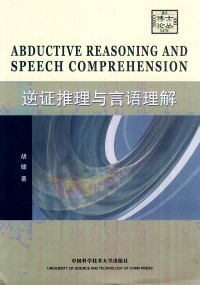简介
本书主要介绍了逆证推理理论,并且讲述了如何运用该理论去理解言语,第一章综合介绍了作者研究的起源和目的以及成果。第二章重点介绍了皮尔斯逆证理论的发展过程。第三章介绍了关于认知语境的一些基本理论。第四章讲述了两种重要的语用推理模式。第五章主要介绍了三种类型的创造性逆证在言语理解中的作用。书稿的研究进一步充实和发展了语用学方面的理论。
目录
Preface
Chapterl Introduction
1.1 Position and general orientation
1.2 Abduction: background and issues
1.2.1 Roots of abduction
1.2.2 Abduction in everyday life
1.2.3 Abduction in scientific reasoning
1.2.4 Abduction in artificial intelligence
1.3 Organization of the bookChapter 2 Towards an Understanding of the Notion of
Abduction
2.1 Introduction
2.2 Peirce's theories of abduction
2.2.1 The syllogistic theory
2.2.2 The inferential theory
2.3 Abduction and induction
2.4 Features of abduction
2.5 Abductive reasoning we talk on
2.5.1 Abduction: inference to the best explanation
2.5.2 Selective abduction and creative abduction
2.5.3 Abductive triggers
2.5.4 Defining abduction
2.6 Chapter summaryChapter 3 Cognitive Contexts
3.1 Introduction
3.2 Study of context: socio-anthropological tradition
3.3 Study of context in pragmatics and cognitive linguistics
3.3.1 A general introduction
3.3.2 Major contextual elements
3.3.3 Cognitive context units
3.4 Chapter summaryChapter 4 Abductive Reasoning in Natural Language Interpretation
and Pragmatic Inference as Abduction
4.1 Introduction
4.2 Abduction in natural language interpretation
4.3 Verbal communication paradigms
4.3.1 Encoding and decoding paradigm
4.3.2 Communicative intentions
4.3.3 Perspective taking
4.3.4 Dialogism
4.3.5 Conclusion
4.4 Pragmatic inference and abductive reasoning
4.4.1 Cooperative principle and conversational implicature
4.4.2 Relevance theory
4.4.3 Abductive reasoning and pragmatic inference
4.4.4 Principle of economy
4.5 Chapter summaryChapter 5 Creative Abduction and Linguistic Interpretation
5.1 Introduction
5.2 Three categories of creative abduction in linguistic
interpretation
5.2.1 Realizing new meanings .,
……
Chapter 5 Conclusion
References
Chapterl Introduction
1.1 Position and general orientation
1.2 Abduction: background and issues
1.2.1 Roots of abduction
1.2.2 Abduction in everyday life
1.2.3 Abduction in scientific reasoning
1.2.4 Abduction in artificial intelligence
1.3 Organization of the bookChapter 2 Towards an Understanding of the Notion of
Abduction
2.1 Introduction
2.2 Peirce's theories of abduction
2.2.1 The syllogistic theory
2.2.2 The inferential theory
2.3 Abduction and induction
2.4 Features of abduction
2.5 Abductive reasoning we talk on
2.5.1 Abduction: inference to the best explanation
2.5.2 Selective abduction and creative abduction
2.5.3 Abductive triggers
2.5.4 Defining abduction
2.6 Chapter summaryChapter 3 Cognitive Contexts
3.1 Introduction
3.2 Study of context: socio-anthropological tradition
3.3 Study of context in pragmatics and cognitive linguistics
3.3.1 A general introduction
3.3.2 Major contextual elements
3.3.3 Cognitive context units
3.4 Chapter summaryChapter 4 Abductive Reasoning in Natural Language Interpretation
and Pragmatic Inference as Abduction
4.1 Introduction
4.2 Abduction in natural language interpretation
4.3 Verbal communication paradigms
4.3.1 Encoding and decoding paradigm
4.3.2 Communicative intentions
4.3.3 Perspective taking
4.3.4 Dialogism
4.3.5 Conclusion
4.4 Pragmatic inference and abductive reasoning
4.4.1 Cooperative principle and conversational implicature
4.4.2 Relevance theory
4.4.3 Abductive reasoning and pragmatic inference
4.4.4 Principle of economy
4.5 Chapter summaryChapter 5 Creative Abduction and Linguistic Interpretation
5.1 Introduction
5.2 Three categories of creative abduction in linguistic
interpretation
5.2.1 Realizing new meanings .,
……
Chapter 5 Conclusion
References
Abductive reasonging and speech comprehension
- 名称
- 类型
- 大小
光盘服务联系方式: 020-38250260 客服QQ:4006604884
云图客服:
用户发送的提问,这种方式就需要有位在线客服来回答用户的问题,这种 就属于对话式的,问题是这种提问是否需要用户登录才能提问
Video Player
×
Audio Player
×
pdf Player
×



